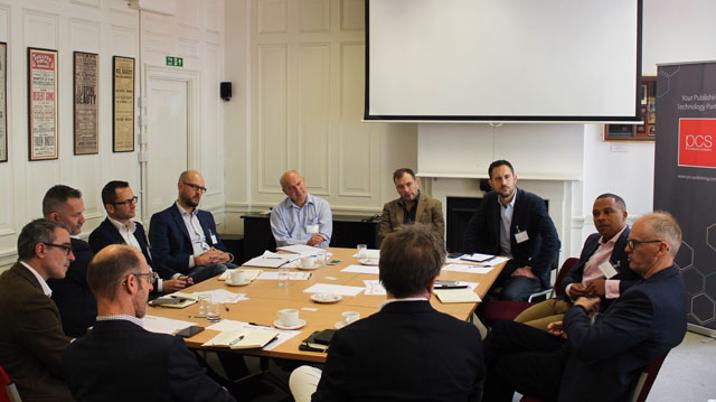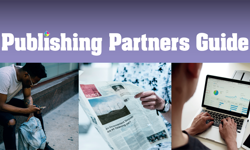
The topics were wide ranging and, as you’d expect, the experiences and priorities varied depending on the sector, although certain universal themes held true.
Content Creation and Distribution
Long gone are the days when every title had to have an app. One B2B publisher had recently retired all their apps because they were seeing no ROI; they had a responsive website, so the publisher could see no point in also having an app. Where apps were enjoying success was where there was a clear utility and purpose, often linked to particular events like large trade or consumer shows, or where, say, frontline medical or pharmacy staff required the latest information on treatments. But we no longer live in a world every publisher has to have an app.
For consumer titles, print was still the primary publishing platform, and everything still revolved around the rhythm of the print production schedule. In B2B, even where there was still a print component, it was digital-first although they had not arrived at this point without some pain along the way; print-first is hard-wired into many journalists and some publishers found they could only get full buy-in for digital-first from their editorial teams by expressly stating that the website was now the primary publishing platform, and repositioning print as a more reflective, less frequent, feature-led read.
Content scheduling was practiced by B2B groups which operated out of multiple geographic locations, for obvious reasons, and consumer publishers would spread the timing of social media posts for maximum impact, but for many publishers, it was still a question of simply getting “stuff up as soon as possible”, irrespective of posting time and date.
In slight defiance of one widely held publishing maxim – that one should publish as much stuff as possible as often as possible – one B2B publisher was consciously slowing things down, certainly in relation to home page layouts. They’d found that users tired of too high a turnover of articles and, unless there was a big breaking story, they were trying to keep the home page reasonably static within any 24-hour cycle.
All publishers used social media and I don’t recall anyone agonising over whether or not they made money from it. They all saw social media as a sensible exercise in brand building and driving traffic to the publishers’ own site or app, or, in the case of consumer media, to the newsagent.
Whilst consumer publishers tended to use Facebook and other social media platforms to alert their audience to particular events, B2B still relied heavily on email.
Perhaps seen in some youth markets as something “one’s uncle does”, email remains a key pillar of B2B and academic publishing.
Technical advances have led to improved rendering of emails, so they look a lot better than they used to and GDPR (which, incidentally, got a collective thumbs up) has encouraged publishers to improve the quality and relevance of email content and its targeting, as well as highlighting to commercial clients the value of publishers’ super-engaged audiences.
For publishers that do a lot of email marketing, high bounce rates – once seen as a bad thing – and long page dwell times, show that emails are doing their job of driving traffic to specific articles.
Increasingly, also, email is becoming a publishing medium in its own right with some articles only appearing in email newsletters. Subject-specific and build-your-own curated email newsletters are also growing in popularity.
Some publishers are also finding success in allowing readers to “follow” particular topics and, especially, authors.
Similarly, some publishers were experimenting with surfacing content via ‘least-read’ mechanisms as opposed to ‘most-read’ which tend to be self-perpetuating.
Other trends include more intelligent use of triggered email alerts (not just for “abandoned carts”) and smaller lists as publishers clean up their files of gone-aways and probably-were-never-theres. This list shrinkage has caused some misplaced angst amongst marketers, but hey, chin up: they were never really there in the first place and at least open rates are going up!
Audience
For all publishers, an ongoing challenge is readership data – finding out as much as possible about the people who consumer our output. For consumer publishers, with large newsstand copy sales or, even, radio listenership, the challenge is to move people up the marketing pyramid from ‘unknown and unengaged’ through ‘engaged, but unknown’ to the ideal state of ‘engaged and known’. It’s a never-ending process of accumulating, appending and overlaying data.
Data sources range from good old-fashioned competitions and reader surveys, through social media, app and podcast sign-ups, subscriptions, loyalty programmes (although more a newspaper thing), to sophisticated tech stacks that identify and build profiles of site visitors, though the challenge for many publishers is to stay on the right side of “creepy”.
For predominantly newsstand publishers, a comprehensive single customer view is a pipe dream as long as single copy sales remain the main sales channel.
B2B publishers, though, have a much more complete picture of their customers and for those with high levels of paid-subscribers, it’s all about renewals – collecting data on usage, identifying infrequent users that are at risk of not renewing, and creating engagement plans accordingly.
Whilst a certain amount of data comes as part and parcel of the subscription sign-up process, there are subtle differences in the challenges publishers face, depending on the nature of the subscription. Increasingly popular, and lucrative, are site licences, which present a number of data collection hurdles. The main purchasing contact will be known, but not all the individuals covered by the site license, who might only be identified by an IP address. For those, typical strategies to flush them out include developing additional tools and services that require individual sign-up and at that point, publishers can at least match a name, job title and email address to an IP address.
For all publishers, it’s a constant battle to accumulate meaningful information about those who consumer our products: B2B and academic, being closer to their users, find it easier. There would seem to be a considerable digital divide between consumer and B2B.
Commercial
There was widespread dissatisfaction with programmatic advertising, which many felt was accelerating a “race to the bottom”. The supply chain was too long and complicated and the end result was a very poor yield of 20-30p in the pound.
For some, it was a matter of having to put up with it for the time being, while working to improve the situation through shortening the supply chain and making incremental changes to improve yield, whilst recognising that it would be phased out in the long term.
Most B2B publishers worked primarily on the ‘tenancy’ approach, with some leaving aside a small portion of inventory for programmatic – a kind of tease to get them through the door, before converting them to direct sale.
There was a short existential debate over the future of ads full stop, with “people just don’t like ads” being one view, balanced by the counter argument that there was actually a societal need for ads – people and companies had things and products they wanted to tell people about…
Those who saw no future in ads pointed to the growing trend of charging for content, either directly or via third party ‘subscription wallet’ services where the publisher would get a payment (maybe just fractions of a penny) per engagement.
A complicating factor was the poor and indiscriminate serving of intrusive and irritating ads, which was hurting the industry as a whole. Growing numbers of publishers were either offering clients their own ‘ad guarantees’ or signing up to best-practice schemes sponsored by bodies like the AOP.
In terms of metrics, there was some frustration with CPM (described by one as standing for ‘Crap Publishing Metric’) and growing adoption of the CPH (Cost per hour) metric pioneered by the FT. For one publisher who was heading down this route, a lot of effort was being put into delivering the best possible ad experience, both for the client and the reader. This meant no more than one ad placement being visible on screen at any one time, which over the length of a long-form article, might translate into four or five ads per page and, when it comes to charging the client, only charging for those ads that had been in view for at least five seconds.
For many publishers, the back-end CRM systems used to manage client contacts and bookings continue to give headaches, often as much down to sales staff’s seeming inability to fill out forms properly – that old favourite, ‘crap in, crap out’. As for the Herculean task of sorting that out, it was a question of training and management, and the sensible deployment of digital carrots and sticks to “encourage” better performance.
One attendee was enthusiastic about the new CRM system he was on the verge on installing, which he said offered a “virtually Google-esque” ability to slice and dice the data. His one concern was that giving sales people the ability to interrogate sales data on the road, might encourage poor preparation – why bother preparing for a sales presentation in advance, when you can do it on the fly, from the car park. But, as someone else pointed out, that’s more a matter of setting up permissions and controls: make sales people earn the right for full unfettered remote access.
New Product Development
There was much discussion on the subject of new product development and the best way of approaching it. Lots of good suggestions bubbled to the surface, including these eight tips for NPD success: 1. Write the press release first. Get the stakeholders to write a press release announcing the launch of the new product at the start of the process. This will get them to think about the desired outcomes and is likely to be more instructive for the development team than a formal spec. 2. Ring fence the development team. Resources permitting, shut them away and let them get on with it. 3. Choose a project owner, who shouldn’t be the editor. Your editor will be good at many things, but managing a development team is unlikely to be one of them. 4. Beware the HIPPO (highest paid person’s opinion). Their opinion is certainly worth hearing, but should not be the yardstick. There was a feeling in the room that part of their job role was providing push-back when needed. 5. Concentrate your limited development resources wisely. Do you want to spend twelve months developing an e-commerce front end, when you can use Shopify? 6. Embrace the concept of minimum viable product, but recognise that two people might have very different definitions of what constitutes ‘minimum’. Tech leaders need to be assertive to avoid projects being derailed. Pixel-perfect should not be a pre-requisite of launching. 7. Ban print-outs in meetings. Everything should be shown on screen. 8. Don’t get sentimental. “Products are not babies; they can be killed.”
On a broader level, managing expectations, tight project control, intelligent budgeting all goes without saying. Probably the best facilitator of good NPD is a clear company vision, which if well articulated can provide a yardstick against which all new product plans are judged. Does it do A, B and C? If so, go for it; if not, drop it.
The Future
Our moderator, Paul Hood, closed the session by posing two final questions: Firstly, if you had a magic wand, what would you wish for and, secondly, what will the publishing industry look like in five years’ time?
In response to the magic wand question, perhaps unsurprisingly, a common answer was “more resource”; specifically, some felt that there was a need to reinvest more of the considerable cost savings companies were making through better efficiencies, back into the business.
“Better prioritisation and a clear corporate strategy” were also high on the wish list, along with the adoption of a more holistic approach to digital development.
As for that old chestnut about where we would all be in five years’ time, one said that he never answered that question on principle! Because he couldn’t see the point. Where we would be in five years’ time depended on where we would be in twelve months’ time!
Another thought the question a bit futile: after all, “what is publishing?” Whatever it is, he thought, it will be affected by global external factors beyond our control.
More down to earth, on the B2B side, there would be a continuation of the move away from prepacked content to embedding data and intelligence tools into client workflows.
In consumer media, there would be further consolidation as big publishers sought greater scale. Those publishers would cherry-pick the most viable brands and build 360-degree services around them, whilst leaving more marginal brands to fend for themselves. Brutal, but already happening.
For an industry in the midst of so much upheaval and where the trajectory is for further, even more disruptive change, I was struck by how sanguine everyone was. I did not sense that anyone in the room felt they were rearranging deckchairs on the Titanic – just a matter-of-fact acceptance of monumental change and our collective need to face it intelligently.
Who was there
Moderator: Paul Hood, Interim Digital Marketing Director, The Sun
John Barnes, Interim Chief Digital Officer, Infopro Digital
Robin Barnes, Digital Director, Cedar
Giles Bentley, Development & Operations Director, TI Media
Peter Dakin, Digital Technology Director, Metropolis Group
Matt Hobley, Head of Digital, Hemming Group
Jeremy Macdonald, Director of Technology, Royal Pharmaceutical Society
Adrian Poole, Chief Information Officer, Bauer Media Group
Richard Sacré, IT Director, Seven
Simon Weare, Head of Development, PCS
The roundtable was sponsored by PCS Publishing, creators of software solutions for publishers, including Knowledge Publish (editorial) and Knowledge Prospect (sales and customer management).
Contact:
Hannah Lloyd
01902 442267










